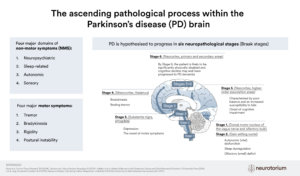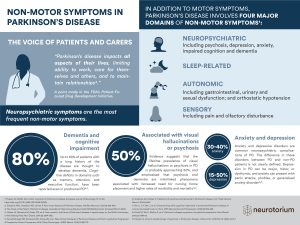Index for
slide deck
Title
-1024x576.jpg)
Epidemiology and burden
Parkinson disease is the second-most common neurodegenerative disorder, after Alzheimers disease. The presentation covers how Parkinson’s disease is spread across different regions across the globe.
Prevalence of Parkinson’s disease
-1024x576.jpg)
Prevalence of Parkinson’s disease
-1024x576.jpg)
Parkinson’s disease is a widespread public health issue
Worldwide, PD is the second-most common neurodegenerative disorder, after Alzheimer’s disease.[Tanner & Goldman, 1996] It is difficult to estimate the total number of people in the world who are affected by PD, as the methods used to collect this data differ between count…
-1024x576.jpg)
Prevalence of Parkinson’s disease in the USA
The Michael J. Fox Foundation for Parkinson’s Research (a leading US charity) estimates that approximately 1 million individuals in the USA, are living with PD.[Michael J. Fox Foundation for Parkinson’s Research, 2017]
A recent analysis of US Medicarea data showed an appr…
-1024x576.jpg)
Prevalence of Parkinson’s disease in Europe
A meta-analysis estimated the prevalence of PD, using data collected by various studies of Western European countries between 1961 and 2000.[von Campenhausen et al., 2015] Using the best quality evidence from these studies, the meta-analysis estimated a prevalence of appr…
-1024x576.jpg)
Prevalence of Parkinson’s disease in China
A multi-centre study in China reported that the prevalence of PD was 2.4% in Chinese veterans aged ≥60 years.[Zou et al., 2014] This is comparable to the burden of PD in other developed, and developing countries.[Zou et al., 2014] This observation is in contrast to an ear…
-1024x576.jpg)
Prevalence of Parkinson’s disease by age
The prevalence of PD increases with advancing age.[Zou et al., 2014] In a meta-analysis of worldwide prevalence data, PD was found to be approximately 40 times more prevalent in populations aged ≥80 years than in those aged 40–49 years.[Pringsheim et al., 2014] Generally,…
-1024x576.jpg)
Prevalence of Parkinson’s disease by sex
Although there is strong evidence to indicate that a person is more likely to develop PD as they become older, the effect of gender is less clear-cut.[Pringsheim et al., 2014]
A recent analysis of worldwide data found generally higher levels of PD in male populations.[Pri…
-1024x576.jpg)
Predictions of the increase in Parkinson’s disease prevalence
Life expectancy continues to grow in the world’s rapidly developing transitional countries, including in China.[United Nations, 2015] As survival rates improve, due to better economic conditions and healthcare, the prevalence of age-related chronic diseases (including PD)…
-1024x576.jpg)
Risk factors associated with Parkinson’s disease
Approximately 90% of PD cases are ‘sporadic’ or ‘idiopathic’, meaning that the cause is unknown.[Thomas & Beal, 2007] However, the disease is known to cluster in families, with <10% of patients reporting a family history of PD.[Thomas & Beal, 2007] Only five single genes …
The burden of Parkinson’s disease
-1024x576.jpg)
The burden of Parkinson’s disease
-1024x576.jpg)
The economic burden of Parkinson’s disease
The economic impact of PD to a healthcare system, and to society, can be considerable.[Huse et al., 2005]
A study in the USA estimated the costs associated with PD over approximately 4 years, using data from more than 20,000 patients who were diagnosed with the disease.[H…
-1024x576.jpg)
The indirect costs of Parkinson’s disease
Indirect costs were introduced on the previous slide and, in the study discussed, they were the main contributors to the overall economic burden of PD.[Huse et al., 2005]
The slide presents a general definition for the indirect costs of human disease and illness, further …
-1024x576.jpg)
The costs of hospitalisation
Direct costs include those associated with the use of healthcare resources, such as inpatient/outpatient care, and drugs.[Huse et al., 2005; Findley, 2007]
A UK survey evaluated the costs associated with the use of healthcare services in 432 patients diagnosed with PD.[F…
-1024x576.jpg)
The increasing economic burden of Parkinson’s disease
The previous slide showed that the direct costs of PD care increased over decades with advancing age, mainly due to worsening disease severity.[Findley, 2007; Findley et al., 2003]
Evidence from a study conducted within the Spanish healthcare system suggests that the incr…
-1024x576.jpg)
The predicted burden of Parkinson’s disease in the future
To help healthcare systems plan for the future, it is important to forecast the requirement for resources.
The number of people diagnosed with PD in the USA is predicted to more than double in the 30-year period from 2010 to 2040, as are the associated costs.[Kowal et al.…
-1024x576.jpg)
The burden of Parkinson’s disease on the patient
The burden of PD is not confined to its economic impact; the disease also has a considerable detrimental effect on a patient’s quality of life (i.e., their general well-being).
In patients with PD, quality of life can be affected from both a physical and mental health per…
-1024x576.jpg)
The burden of non-motor symptoms on the patient
Non-motor symptoms of PD can be present for many years before the characteristic motor symptoms appear.[Duncan et al., 2014] These non-motor symptoms may affect an individual’s quality of life well before a formal diagnosis has been made.[Duncan et al., 2014] A study cond…
-1024x576.jpg)
The burden of Parkinson’s disease on caregivers
The progressive disabling effect of PD on an individual means that they will inevitably require some form of care, usually provided by a relative or friend.[Peters, 2014; Martinez-Martin et al., 2012] The caregiving role is all-encompassing as carers provide wide-ranging…
-1024x576.jpg)
The burden of the cognitive symptoms of Parkinson’s disease on caregivers
There are many aspects of PD that can intensify the caregiver burden (e.g., impaired movement, sleep disorders, pain, cognitive impairment, etc.).[Martinez-Martin et al., 2012]
Attentional deficits may have a negative impact on the ability of people with PD to perform ba…
-1024x576.jpg)
Parkinson’s disease is a disease with growing prevalence and negative effects on quality of life
Reference used on slide:
Boland DF, Stacy M. The economic and quality of life burden associated with Parkinson’s disease: a focus on symptoms. Am J Manag Care 2012; 18 (7 Suppl): S168–S175.




